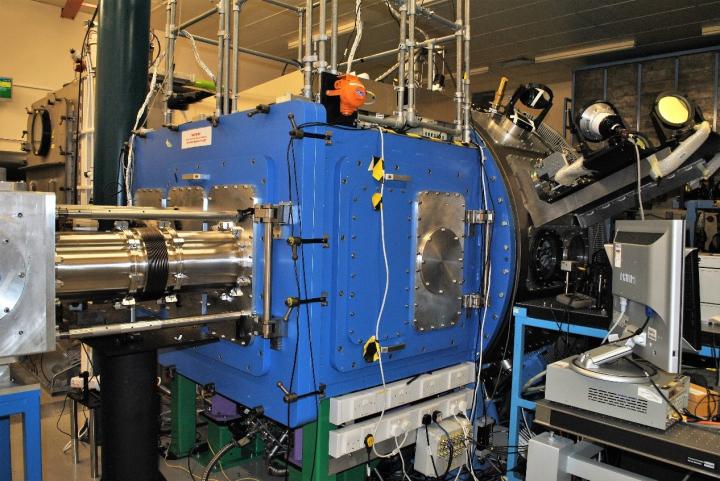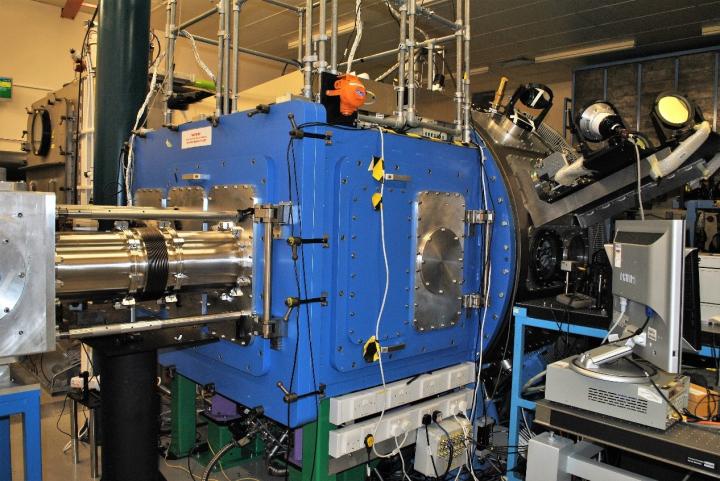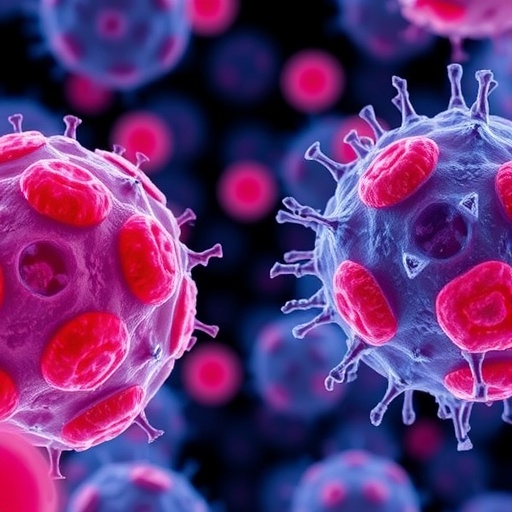
Credit: University of Strathclyde
The world's highest gain high power laser amplifier – by many orders of magnitude – has been developed in research led at the University of Strathclyde.
The researchers demonstrated the feasibility of using plasma to amplify short laser pulses of picojoule-level energy up to 100 millijoules, which is a 'gain' or amplification of more than eight orders of magnitude – which could be likened to amplifying the sound of rustling leaves to that of a jumbo jet – in only two mm of plasma.
They used 150 J pulses from the powerful Vulcan laser system at the Science and Technology Facilities Council's Central Laser Facility (CLF). Over the course of two pioneering experiments at the CLF, the scientists worked closely with CLF staff to adapt the Vulcan laser in order that two different colour lasers could exchange energy in a plasma. The measured gain coefficient of 180 cm-1 is more than 100 times larger than achievable from existing high power laser system amplifiers based on solid-state media.
The results have been published in the journal Scientific Reports, in an article entitled An ultra-high gain and efficient amplifier based on Raman amplification in plasma.
Professor Dino Jaroszynski, of Strathclyde's Department of Physics, led the research. He said: "Raman amplification in plasma is a fascinating concept that combines the ideas of Nobel Physics laureate CV Raman with plasma, optical and laser physics.
Here, a relatively long, high-energy laser pulse is made to collide in plasma with a short, very low energy pulse. At the point where they collide they produce a beat wave, much like that of two colliding water waves. The light pressure of the beat pattern drives plasma electrons into a regular pattern or echelon that mimics the beat wave. This multi-layer echelon acts as a very high reflectivity, time-varying mirror that sweeps up the energy of the high energy pulse reflecting it into the low energy pulse, thus amplifying the low energy pulse and compressing its energy into an ultra-short duration pulse of light.
"Our results are very significant in that they demonstrate the flexibility of the plasma medium as a very high gain amplifier medium. We also show that the efficiency of the amplifier can be quite large, at least 10%, which is unprecedented and can be increased further. However, it also shows what still needs to be understood and controlled in order to achieve a single stage high-gain, high-efficiency amplifier module.
"One example of the challenges that we still face is how to deal with amplification of 'noise' produced by random plasma fluctuations, which is exacerbated by the extremely high gain. This leads to undesirable channels for the energy to go. We are making excellent progress and believe that we are in an excellent position to solve these problems in our next experimental campaigns."
Dr Gregory Vieux who led the research team working at the CLF, said: "Plasma is a very attractive medium to work with. It has no damage threshold since it is already a fully broken-down medium, therefore we can use it to amplify short laser pulses without the need for stretching and re-compressing. Another advantage is that further compression during the amplification is theoretically possible. This could pave the way for the development of the next generation of laser systems delivering ultra-intense and ultra-short pulses and at a fraction of the cost of existing lasers.
"Still, we are not quite there yet. The scheme relies on controlling the Raman instability. It has such a large growth factor that it can develop and grow from small plasma fluctuations."
Laser amplifiers are devices that amplify light. In those that are familiar to us, this is done by synchronising the light emission from electrons in atoms or solid state matter, to make it coherent, which is a necessary step to achieving very high powers. However, very high power lasers at the frontier of technology are limited by damage to their optical components and amplifying media. This makes them very large and very expensive.
Plasma, the ubiquitous medium of the universe, offers a way around this limitation because it is very robust and resistant to damage – plasma can be seen as matter that has already been broken down into its smallest constituent elements: electrons and ions. By harnessing waves in plasma we can dramatically reduce the size of laser amplifiers while providing a route to much higher peak powers than possible now, exceeding the petawatt range to possibly reach exawatts. This is a very worthy goal because very intense laser pulses can be used for fundamental studies, such as accelerating particles, helping drive nuclear fusion or even extracting particles from vacuum and recreating the conditions inside stars or the primordial condition of the universe in the laboratory.
The highest power lasers in the world will be available for use at three research centres that are part of the European Extreme Light Infrastructure (ELI) project. This €850m project is dedicated to the study of light-matter interactions at the highest intensities and shortest time scales. The laser power at ELI will be 1016 Watts or 5% of the total sun's power that is absorbed on the earth at any time. These lasers will lead to new science and technology that could, for example, transform our understanding of high field physics and result in new radiotherapy modalities for the treatment of cancer. There is a need to reduce the cost of laser technology, which plasma could offer. Plasma may be a route to higher powers to go beyond those available at ELI to reach exawatt powers.
###
The investigation was a collaboration between researchers from Strathclyde, Instituto Superior Técnico (IST) in Lisbon, Queens University Belfast, Ulsan National Institute of Science and Technology (UNIST) in South Korea, Heinrich Heine Universität, Düsseldorf and the Extreme Light Infrastructure in the Czech Republic. It was funded by the Engineering and Physical Sciences Research Council.
The Research Excellence Framework 2014, the comprehensive rating of UK universities' research, ranked the University of Strathclyde's Physics research first in the UK, with 96% of output assessed as world-leading or internationally excellent.
Media Contact
Corporate Comms
[email protected]
44-014-154-82370
http://www.strath.ac.uk
############
Story Source: Materials provided by Scienmag





